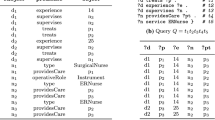Abstract
In knowledge bases (KB), the open world assumption and the ability to express variables may lead to an answer redundancy problem. This problem occurs when the returned answers are comparable. In this paper, we define a framework to distinguish amongst answers. Our method is based on adding contextual knowledge extracted from the KB. The construction of such descriptions allows clarification of the notion of redundancy between answers, based not only on the images of the requested pattern but also on the whole KB. We propose a definition for the set of answers to be computed from a query, which ensures both properties of non-redundancy and completeness. While all answers of this set can be distinguished from others with a description, an open question remains concerning what is a good description to return to an end-user. We introduce the notion of smart answer and give an algorithm that computes a set of smart answers based on a vertex neighborhood distance.
Preview
Unable to display preview. Download preview PDF.
Similar content being viewed by others
References
Prud’hommeaux, E., Seaborne, A.: SPARQL Query Language for RDF. Technical report, W3C (2008)
Leclère, M., Moreau, N.: Query-answering cg knowledge bases. In: Eklund, P., Haemmerlé, O. (eds.) ICCS 2008. LNCS, vol. 5113, pp. 147–160. Springer, Heidelberg (2008)
Lin, J.J., Quan, D., Sinha, V., Bakshi, K., Huynh, D., Katz, B., Karger, D.R.: What makes a good answer? the role of context in question answering. In: INTERACT (2003)
Croitoru, M., van Deemter, K.: A Conceptual Graph approach to the Generation of Referring Expressions. In: Proceedings of the 20th International Joint Conference on Artificial Intelligenc, IJCAI 2007 (2007)
Gutierrez, C., Hurtado, C., Mendelzon, A.O.: Foundations of semantic web databases. In: PODS 2004: Proceedings of the twenty-third ACM SIGMOD-SIGACT-SIGART symposium on Principles of database systems, pp. 95–106. ACM Press, New York (2004)
Fikes, R., Hayes, P., Horrocks, I.: OWL-QL, a language for deductive query answering on the Semantic Web. Web Semantics: Science, Services and Agents on the World Wide Web 2(1), 19–29 (2004)
Chein, M., Mugnier, M.-L.: Conceptual Graphs: Fundamental Notions. Revue d’Intelligence Artificielle 6(4), 365–406 (1992)
Sowa, J.F.: Conceptual Structures: Information Processing in Mind and Machine. Addison-Wesley, Reading (1984)
Baget, J.-F., Mugnier, M.-L.: The SG family: Extensions of simple conceptual graphs. In: IJCAI, pp. 205–212 (2001)
Mugnier, M.L.: On generalization/specialization for conceptual graphs. Journal of Experimental & Theoretical Artificial Intelligence 7(3), 325–344 (1995)
Author information
Authors and Affiliations
Editor information
Editors and Affiliations
Rights and permissions
Copyright information
© 2009 Springer-Verlag Berlin Heidelberg
About this paper
Cite this paper
Moreau, N., Leclère, M., Croitoru, M. (2009). Distinguishing Answers in Conceptual Graph Knowledge Bases. In: Rudolph, S., Dau, F., Kuznetsov, S.O. (eds) Conceptual Structures: Leveraging Semantic Technologies. ICCS 2009. Lecture Notes in Computer Science(), vol 5662. Springer, Berlin, Heidelberg. https://doi.org/10.1007/978-3-642-03079-6_18
Download citation
DOI: https://doi.org/10.1007/978-3-642-03079-6_18
Publisher Name: Springer, Berlin, Heidelberg
Print ISBN: 978-3-642-03078-9
Online ISBN: 978-3-642-03079-6
eBook Packages: Computer ScienceComputer Science (R0)




